Face masks have so far proved to be the most effective first line of defense against all contagious epidemics and pandemics.
However, the biggest discomfort with face masks is the difficulty in breathing and accessing fresh air. On the other hand, if the masks are made porous for letting fresh air in could also allowing Covid-19 germs a safe passage inside the mask, defeating the main purpose of the mask.
If a provision is made wherein the air entering the mask is forced to pass through a quick disinfecting agent such as a UVC light channel, could possibly inactivate all pathogen including coronavirus, providing a healthier air for the user inside the face mask.
In the post below I have made an attempt in this direction with an innovative face mask idea that would disinfect the air entering the mask using UVGI concept, allowing the user to breathe much freely.
How UVGI can be Effective
UVGI technology stands for ultraviolet germicidal irradiation, that involves using the destructive properties of UV rays against pathogens, to eliminate them through UV irradiation.
Researchers have found that when pathogens are irradiated with concentrated UVC rays, their RNA material is quickly broken down and destroyed.
In our face mask disinfection concept, since the air has to first pass through a narrow channel, irradiated with concentrated UVC, is able to inflict maximum destructive properties on the viruses travelling through this passage.
What is UVC
In the term UVC, UV stands for UltraViolet, and C signifies the wavelength category of the UV light ,which is between 100 and 280 nm, as depicted in the following image:


The wavelength falling in the range between 100 and 280 nm is the ultraviolet range which has the ability to eliminate all forms of pathogens including bacteria and viruses.
UVC LED
Nowadays, it is possible to get specialized germicidal LEDs designed for generating UVC light in the range of 250 to 280 nm. These UV lights have proven to be quite competent in inactivating viruses entering its light zone.
You can see a few example of SMD UVC LED in the following figures which can be applied for the [proposed face mask air disinfection application. You can also also check out the adjoining datasheets.

datasheet1, datasheet2, datasheet3
Due to the fact that UVC in this range may be also harmful for human skin, that's exactly why the UVC LED in this concept has been confined inside a separate enclosure prohibiting any contact of the light with the human skin.
Applying UVC in Face Masks
Since UVC germicidal LEDs are now easily accessible, implementing them in innovative germicidal applications has now become easy.
In critical pandemics such as COVID 19 when wearing masks is a compulsion for everybody especially for all the healthcare workers, it can be a lot of inconvenience and stressful times for these
The concept shown in the following image could be used as an external attachment for face masks in order to enable fresh disinfected air for the user.
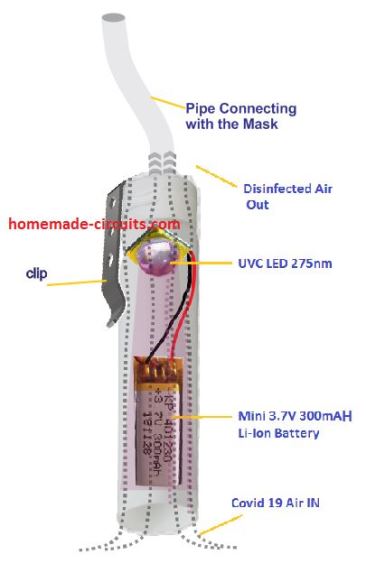
Here, we can see a small cylindrical tube enclosing an UVC LED and a Li-Ion battery. The lower mouth of the tube is open for enabling the atmospheric air or possibly infected air to enter the tube, while the other end is attached with a pipe which connects with the face mask. The connection set up can be witnessed in the following image.
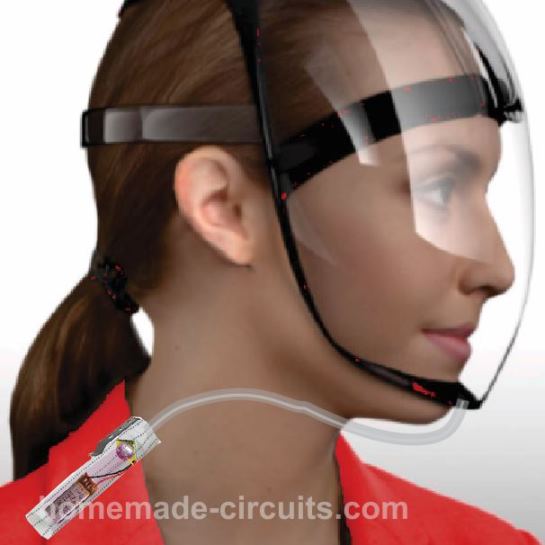
If the tube connection looks cumbersome and messy, it could be improvised into a plug-in type unit as shown in the following example
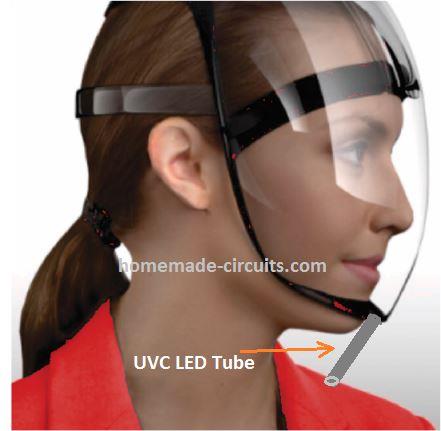
The set up allows the air to enter the tube, and get disinfected by the UV light, and then move ahead through the connecting pipe into the face mask interior.
When the user exhales, the opposite happens. Now, the exhaled air exits out from the tube, and in the process gets disinfected while moving out from the tube.
This way the UVC LED disinfects the air both ways, while inhalation and exhalation, thus helping greatly to suppress the spreading of the contagious disease.
Which type of Face Masks can be Used?
Since the design requires the connections to be rigid and firm, cloth face masks may not be compatible with this concept, rather the ones built with plastic or other harder material might be more suitable.
Which Battery Can be Used
Since the current consumption of the specified UVC LED is just 60 mA, a tiny 3.7 V 300 mAh Li-Ion or Lipo battery will be enough to provide a back up for more than 4 hours on each charging.
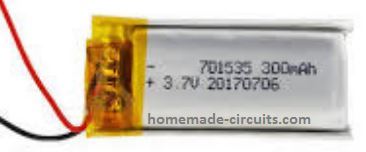
Specifications of 3.7V 300 mAH Lipo Battery:-
- Voltage: 3.7 V
- Capacity: 300 mAh
- Size approx : 30 mm x 20 mm x 4 mm
How to Charge the battery
The battery can be charged through any standard Li-Ion battery charger with auto cut off or it may be also implemented using the following simple set up.
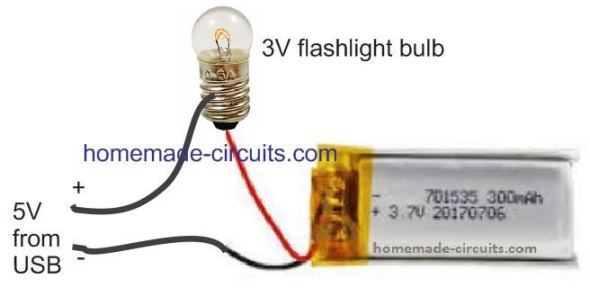
When the glow on the filament of the bulb is almost zero, the battery can be assumed to be fully charged.
In reply to Doug, UVC can only produce Ozone when emitting in the lower spectrum of UVC. The Led’s mentioned in this article typically emit in the middle to upper band of UVC ie 250-280nm. There is therefore no need for any further treatment of the incoming air as nonOzone can be generated. There is also absolute proof that Covid Virus is instanly destroyed by irradiation with the correct frequency of UVC, these lab tests were done in 2014 in America on Covid 14.
Cheers, Norris
Hi there,
Couple points to consider.
Ozone will likely be produced with this arrangement.
You can deal with it catalytically, but your have to deal with it.
The other point is that UVC has not been shown to be an effective agent when air is simply passed over a lamp.
Take care,
Doug
Thanks, Got it, appreciate your valuable feedback and inputs